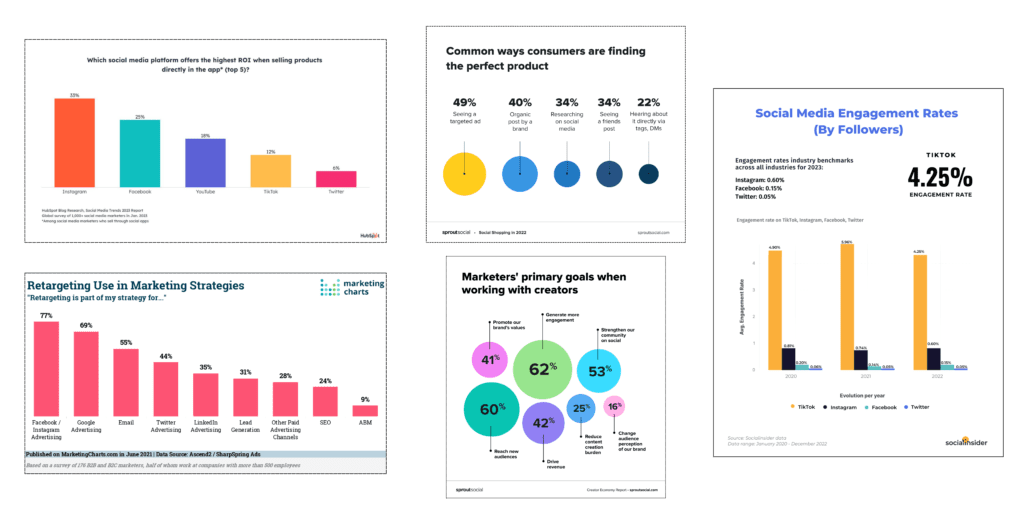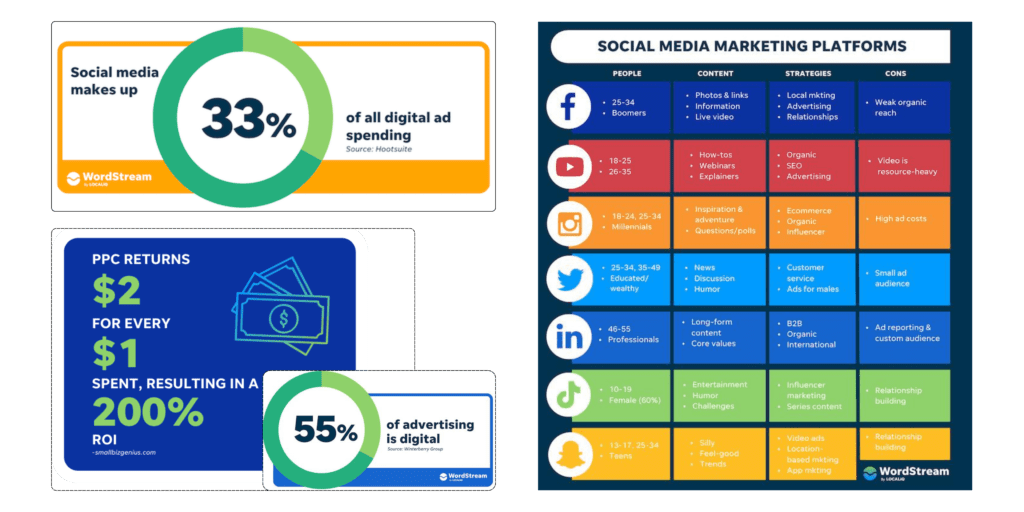
Facebook Advertising
Facebook advertising is the activity of promoting businesses, services, or information on the Facebook network through sponsored advertisements. To reach the intended audience, these ads might target certain demographics, interests, behaviours, and places.
Increase Your Brand Awareness
Businesses benefit from digital marketing in terms of promotions and marketing. Businesses can advertise their goods and services and increase brand recognition by producing interesting content and utilizing social media ads.
Manage your brand’s reputation
This can be accomplished by telling inspiring tales and monitoring how the public feels about your brand.
Targeted Advertising
Social media platforms offer businesses precise targeting options to reach their ideal customers. On Facebook, for instance, you can target your ads to particular demographics, like males 18 years of age and older or college students in a particular city.
Increasing sales
Through innovative social media promotion, your goods and services will be seen by consumers as a brand’s “add-on” or advantage rather than as a marketing initiative.
Cost-effective social media advertising
In general, social media advertising is less expensive than traditional forms of advertising. For instance, Facebook gives advertisers the option to select the demographics they wish to reach and their target audience. With these options, companies can reach a larger audience through targeted messaging while spending less on advertisements.
Build up and maintain relationships
Social media enables you to monitor comments and responses to posted content, allowing you to modify content to appeal to the majority. This helps you give your customers accurate and valuable information.
Enhance brand image and improve brand loyalty
Social media gives businesses the opportunity to interact with consumers and address their questions and grievances, which fosters goodwill and improves brand perception.
Learn more about competitors
Examining the social media posts of your competitors can provide you with valuable insights about where you stand to gain and where you should remain cautious.Let’s take an example where you run a coffee business and the holidays are coming. You’ve noticed that sales aren’t going as well as they usually do. You can see that comparable businesses are serving coffee in festive cups throughout December by looking through social media.
STATITICS


Social media advertising is most commonly used on Facebook, Twitter, LinkedIn, Instagram, Pinterest, Snapchat, TikTok, and YouTube. For instance, a B2B company might not want to use Pinterest, and a fast-moving consumer goods (FMCG) company might not be able to use LinkedIn to promote a successful awareness campaign.
Facebook provides advertisers with extensive advertising options that allow them to run ads during the buyer’s journey stages of awareness, consideration, and conversion.
The average cost per click (CPC) Opens in a new window is $0.94.
Instagram offers ads that are comparable to those on Facebook, and Facebook Ad Manager is the same interface you use to manage ads on both platforms.
The average cost per click (CPC) on Instagram across various industries was $0.94.
Twitter’s advertising solution is fairly simple, much like the platform itself. Twitter has ads in both the news feed and the search area. As an illustration,
Engaging tweets cost $1.35 to click, retweet, and cost $2–$4 for each follower. Promoted trends and hashtags is $200,000.
LinkedIn is a business-focused platform that offers chances for self-promotion for both individuals and brands.
LinkedIn sponsored ad CPCs typically range from $2 to $5.
Snapchat
Due to its popularity among millennials and Generation Z users, Snapchat tends to favor lighthearted and informal content.
Here are six Snapchat ad formats that assist brands in reaching their goals: Snap ads, Collection ads, Story ads, AR lens, Filters, Commercials.
1.What key objectives can be satisfied with Facebook Advertising?
- To raise brand awareness, the more time people spend noticing your brand, the more probable it is that they will recall it.
- The Reach goal is intended to maximise the number of people who see your advertisement while staying within your advertising budget.
- It’s great for driving traffic to your website because the traffic objective will get you as many clicks on links as possible.
- One of the best campaign objectives for getting likes, comments, and shares is the Post Engagement one.
- The “App Installs” campaign goal directs users to the appropriate download page. It can significantly aid in raising the rankings of your app.
- The purpose of lead generation advertisements is to gather contact details like name, phone number, and email address. Ads that generate leads are a great tool for service-oriented businesses.
- Messages campaign objectives are a great way to start a conversation with potential customers when they click on your ads on Facebook Messenger, especially for service-oriented businesses or high-value product promotions.
- The goal of the Store Visits campaign is to close the gap between offline and online marketing. Facebook has acknowledged that many in-store transactions begin with an online conversation.
2. What are the main Facebook advertising formats available?
Image/Photo Ads.
While picture ads are excellent for displaying a single image or message, they are not appropriate for conveying many messages; instead, another type of advertisement would probably be more appropriate.
The intention of image ads is as follows:
- Increase brand awareness by using picture ads.
- Emphasize a specific good or service.
- Send a clear message
Video Ads
Videos are more engaging and dynamic than other forms of advertising. Facebook advised users to extend the duration of the video ad to 15 minutes, and they can use a video template to assist in the creation of it.
Advertise with videos to:
- Increase brand recognition
- Quickly get the attention of the audience
- Send out just one message.
Carousel Ads
Carousel advertisements can contain upto 2 to ten pictures and videos at once. It works well for companies with a limited range of products. Each image in the carousel advertisement has its own headline, description, link, and call to action. It can be navigated and swiped up with ease without requiring page changes.
Use carousel ads to:
- Promote multiple products, each of which links to a separate landing page.
- To display multiple advantages of the same product.
- To outline an orderly process.
Collection ads
A collection ads features a cover image or video with multiple product images. You may get the complete instant experience by clicking on the product photos, which will take you to the landing pages. This kind of advertisement works well for big businesses.
Slideshow Ads
Slide show advertisements are designed to draw in viewers rather than only using still, static images by highlighting the marketed goods and services with text and movement. It is quick and affordable, producing incredibly appealing visual advertisements.
Stories Ads
Instagram Story advertisements show up as vertical images or videos on the platform. Furthermore, unlike Instagram stories, these advertisements last for as long as we can choose how long the campaign lasts.
It significantly affects that, creating a great conversion rate.
3.How can you target audiences when creating a Facebook advertisement?
Instead of simply running a large-scale advertisement in a specific area without targeting rules, you can reach prospects based on their browsing history and interests by using Facebook’s ad audience targeting options.
The Facebook audiences listed below are those that will yield a high return on investment (ROI).
- Individuals who are considering using your service or product.
- Individuals who have previously purchased your good or service.
- Those who have liked, commented on, or visited your page on Facebook
- The audiences of your competitors.
Your conversion rates will rise if you use Facebook ads to target these audiences with the appropriate strategy and tactics. The three primary Facebook ad audiences to target in order to maximise return on investment are:
Facebook Core Audiences:
One of the best ways to reach people who are most likely to be interested in your campaign is through Facebook’s Core Audience targeting options.
1.Location:
Reaching out to potential clients by using their location is a strategy that is becoming more and more common. Once you organize them by city, region, or nation, you’ll have a population ready for your advertisement!
2. Demographic:
You can select your Facebook target audience by using demographic targeting options on the platform, which include options for age, gender, occupation, job title, and more.
3. Interests
One way to make your advertisement more relevant to them would be to target individuals who have an interest in a particular topic or hobby.
4. Behavior
You can use their browsing history, past purchases, device usage, and other information to target your ads to more relevant users.
5. Connection:
You will be focusing on individuals who have never interacted with your business on Facebook when you exclude them.By removing those who are associated with your page or event, you can use the Facebook core audience targeting options to identify new prospects to target.
Facebook Lookalike Audiences
Facebook advertisers now have an easier time locating and targeting individuals who share their demographics and interests with their target audience thanks to the lookalike Facebook audience tool.While Facebook generates a new audience based on the audience attributes you provided, you have the option to upload a custom audience.Facebook lookalike audiences should be on your audience target list because they convert very well.
Facebook Custom Audiences
- You can use data from your Facebook pixel, SDK, or app visitors to create a custom audience, or you can upload a list of email addresses and phone numbers to Facebook in order to create a custom audience Facebook ad
- Targeting particular groups instead of the Facebook audience as a whole is the primary advantage of utilising Facebook custom audiences.
- You can also use Facebook Custom Audiences to retarget website visitors who have not yet made a purchase from you.
4. Explain the key elements that make up a great Facebook advertisement.
1. Well defined goals
A clearly defined objective should be mentioned. As the business expands, goals may vary, but there needs to be a goal for the advertisement, whether it be to increase website traffic, likes, followers, leads, or anything more.
2. Targeting the right audience
Choosing your target audience can help you create the ideal persona for your campaign, including information about their age, gender, demographics, interests, income level, etc.It is simple to design an appealing campaign for your target audience if you have a persona.
3. Appropriate and high-quality images
Statistics indicate that when designing an ad campaign, high-quality images are crucial since they increase engagement rates on Facebook ads, and it should be according to people’s interests.
4. Strong headlines
Making attention-grabbing headlines will encourage customers from reading advertisements. The attractive lines that provide customers with solutions and address their difficulties.
5. Call-to-action
When you’re done reviewing the advertisement, create a clear call to action (CTA) that directs the viewer to perform a specific action, such as registering, downloading an eBook, subscribing to a newsletter, shopping now, and more.
6.Landing Page
When users click the advertisement to be taken to the landing page and complete a conversion. This advertisement’s URL is typically the same as the final URL of the ad page.

